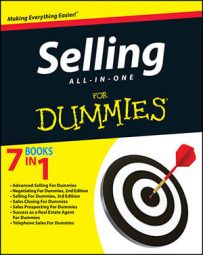The selling cycle breaks down neatly into six steps. Each of these steps is equally valuable and plays a critical role in building a successful career in sales. If you perform each step correctly, the last step (getting referrals) leads you back to the first (making contacts for new prospects). Your happy new client or customer will give you the names of other people she feels would benefit from your product or service, and then you have your next lead or prospect to work with.
Here are the six steps that make up the selling cycle:
Prospect for your next potential client or customer.
Prospecting means finding the right potential buyer for what you’re selling. When considering your product or service, ask yourself, “Who would benefit most from this?” and then look for ways to make contact with those people.
To make an informed decision about which prospects to approach, do some research about any prospective client company at the local library or online. You’ll do even more qualification when you meet a prospective client, but why waste time on an appointment with a company or person who wouldn’t need your offering?
Make initial contact.
To persuade another person to give you her valuable time, you need to offer something of value in return. For example, to gain entrance to someone’s home, consider offering a free estimate or gift in exchange for her opinion on the demonstration of your product. With a business-to-business appointment, getting an appointment may be a bit easier because you’re often working with a purchasing agent whose job it is to meet with and gather information from people like you. If you offer anything remotely like a product that her company may use, it’s her duty to investigate what you have to offer.
Qualify the prospective clients or customers.
Find out whether the prospective client or customer is qualified to be your client. In selling, qualifying your prospects means finding out not just who they are but also what they do, what they have, and what they need in order to confirm that your product or service is a good fit and that they have the resources to invest in it.
Win over the prospects with your presentation.
Your presentation of your product, service, or idea requires the most preparation. In your preparation, practice your answers to common questions with a family member or fellow salesperson. Make a list of the benefits you think are your strongest persuaders in placing your product. Then figure out a way to work those points into responses to the common questions that potential clients ask.
Address the prospective client’s or customer’s concerns.
The best way to handle negative comments or concerns your prospect may raise is to answer in simple, unemotional terms and have recommendations in mind. For example, if your product is available only in certain colors, and none of them quite fit the décor of your prospect’s office, be prepared to point out the least offensive color as being somewhat complementary to her décor. In fact, when you get around to discussing the colors, suggest something like this: “Based on your color scheme, the Sunrise Blue would best complement your décor.” That way, you’ve already seen and addressed the objection before the prospect brought it up.
Close the sale.
If you’ve researched your prospect properly, given yourself enough valuable preparation time, and handled all the previous steps in a professional manner, you’ll likely close the sale. Closing should follow naturally and smoothly after you address your prospect’s concerns. In fact, getting your prospect’s business can be as simple as saying, “How soon do we start?” At this point, if you’re confident about being able to give her what she needs, you should begin taking verbal ownership of your future business relationship with assumptive statements and questions.

